|
 lthough Charles Abbot's 1942 apology and retraction ended the
feud between Orville Wright and the Smithsonian Institution, it did
not answer the question that had started the mess. In his apology
Abbot admitted that, because of the changes made to the aircraft,
the 1914 experiments at Hammondsport did not prove that the
Aerodrome ― in its original configuration ― was "capable of flight."
So the question
remains: Could the 1903 Langley Aerodrome have flown? lthough Charles Abbot's 1942 apology and retraction ended the
feud between Orville Wright and the Smithsonian Institution, it did
not answer the question that had started the mess. In his apology
Abbot admitted that, because of the changes made to the aircraft,
the 1914 experiments at Hammondsport did not prove that the
Aerodrome ― in its original configuration ― was "capable of flight."
So the question
remains: Could the 1903 Langley Aerodrome have flown?
Beyond the
politics, there was a contingent in Washington informally called the
"Langley Society" that believed the original 1903 Langey Aerodrome
could have made a sustained flight with a person aboard if it
had been properly launched. Samuel Langley himself had claimed this
was so shortly after the disastrous launch attempts of 1903. In the
1904 Annual Report to the Board of Regents of the Smithsonian
Institution, Langley said emphatically "...the machine has never
had a chance to fly at all, but that the failure occurred on its
launching ways; and the question of its ability to fly is, as yet,
an untried one...another flight would be successful if the launching
were successful, for in this, and in this alone, as far as is known,
all the trouble has come." Others concurred. In his report to the
US Army Board of Ordinance and Fortification, Major M. M. Macomb
said the 7 October 1903 "...trial was unsuccessful because the front
guy post was caught in its support on the launching car." Of the 8
December launch attempt, he reported, "The rear guy post seemed to
drag, bringing the rudder down on the launching ways and a crashing,
rending sound, followed by the collapse of the rear wings, showed
that the machine had been wrecked in launching."
However, the launching method may have not been the Aerodrome's only
problem. Several aeronautical engineers have studied the 1903
Aerodrome and have concluded that it was not capable of
flight because the structure was too weak and excessively
aeroelastic. That is, the structure could be easily
distorted by the forces in play during flight. In their 1955 book
Aeroelasticity, authors Raymond L. Bisplinghoff, Holt
Ashley, and
Robert L. Halfman observe "Perhaps the
first designer to be affected [by aeroelasticity] was Professor
Samuel L. Langley of the Smithsonian Institution. In light of modern
knowledge, it seems likely that the unfortunate wing failure which
wrecked Langley's machine on the Potomac River houseboat in 1903
could be described as wing torsional divergence."
In 1981, NASA
engineers Wilmer Reed III, Rodney Ricketts, and Robert Doggett
tested the wings of the newly-restored Langley Aerodrome and found
that because of “overall lack of structural rigidity, especially torsional rigidity of the wing
and fuselage, it [is] highly probable
that the collapse of the machine during launch can be attributed
to…overload due to elastic deformations.”
More
recently, in 2004 Lorenzo Auriti and James DeLaurier of the
University of Toronto built models of the Great Aerodrome wings and
conducted wind tunnel tests. They found that during a launch the
wings would twist with the leading edges down and the trailing edges
up; the lower guys posts were subjected to loads beyond their
breaking point, and the guy wires would "yield," depriving the spars
of critical support. Their conclusion was "the Aerodrome was not
capable of flight as launched off the houseboat [in 1903]. The wing
loads found were higher than the structure could support."
According to these experts, the 1903 Aerodrome airframe had two
fatal flaws. First, the wings would not hold their camber or angle
of attack when the air was flowing over them. In the first few
critical moments of flight, the wings twisted or deformed so they
actually pointed the Aerodrome down. Second, the structure would not
support the aircraft in flight, particularly during the stresses of
a catapult launch. The lower guy posts would snap, the wires would
go slack, and the spars would break where they joined the fuselage.
Indeed, both of these flaws seemed to have manifested themselves in the two
launch attempts of 1903.
If you closely examine the 1914-1915 Hammondsport trials, they
support these conclusions. Ironically,
the Smithsonian Institution claimed these same trials to have proved
the Langley Aerodrome was the first aircraft capable of manned
flight. But a detailed
review of the experimental results suggests just the opposite.
Furthermore, the Hammondsport flights expose another potential flaw.
That is, given the inefficient design of the wings and propellers,
the available thrust may not have been sufficient to keep the aircraft
in the air even if the airframe had been stronger.
The initial flights in late May and early June of 1914 plainly show
that the Aerodrome (in its 1914 configuration) could not sustain
flight with its original engine. When the Aerodrome reached flying
speed, skimming across Lake Keuka on its pontoons, the pilot pulled
back on the control lever to pitch the nose up. The airplane would
leave the surface of the lake, but never for more than a few
seconds. It would rise no more than 2 or 3 feet (0.6 to 0.9 meters)
― just enough for the pontoons to leave the water ― and continue for
100 to 150 feet (30 to 45 meters) before it settled back down on the
lake. The standard procedure for this situation would have been for
the pilot to hold the nose level or slightly down and let the
airplane continue in "ground effect" (close to the surface where the
air balls up under the wings and creates additional lift) while it
gained enough speed to climb. Certainly Curtiss tried
this, but the available thrust was not enough to gain speed or
altitude, or even keep the aircraft flying in ground effect.
Clearly embarrassed by this lackluster performance, Curtiss claimed
that the inability to sustain flight was due to increased weight.
The pontoons, he said, added 320 pounds (145 kilograms). The
original Aerodrome had weighed 850 pounds; its Hammondsport
reincarnation weighed 1170 pounds (386 versus 531 kilograms). It was
a believable story, but it was not the whole truth. More important
than excess weight was insufficient thrust. The Aerodrome's
inability to fly was primarily due to the underperformance of its
engine. The Manly-Balzer motor only produced about 35 horsepower,
two-thirds of the power it had delivered in 1903. Curtiss had
compensated for the lack of power as best he could, adding a modern
ignition and carburetor to the motor and reshaping the propellers to
make them more efficient. But it was not enough. Later tests would
show that the reworked engine and propellers produced only 300
pounds of thrust (1335 Newtons), well below the 450 pounds (2002
Newtons) measured in 1903. Curtiss could not explain this to the
public because it would have exposed the central lie of the
Hammondsport trials. Despite press releases to the contrary, the
Aerodrome, excepting its pontoons, was not the same aircraft Langley
had attempted to fly in 1903. There were, in fact, over 30
alterations, including the reworked engine and propellers. Much of
the excess weight had nothing to do with pontoons. It was there
because of the doubled-up spars, solid ribs, A-shaped wing supports
and other parts that Curtiss had added or modified to strengthen the
airframe.
Shortly after the trials on 5 June, Curtiss left Hammondsport for
Buffalo, NY to organize a new factory. He asked Albert Zahm to take
over the investigation of the Aerodrome, but he left instructions
that clearly show that Curtiss understood the true problem. Instead
of reducing weight, he had his crew remove the original engine and substituted
an 80-horsepower motor and modern propeller. In September 1914, the
Aerodrome began to fly, eventually reaching altitudes of 30 feet (9
meters) and traveling for up to 20 miles (32 kilometers). But that
success was tainted for the simple reason that it was accomplished
without the original motor.
So in March 1915, while Lake Keuka was still frozen over, Zahm and
his team reinstalled the original engine, and then replaced the
pontoons with skates. This reduced the weight of the Aerodrome to
995 pounds (451 kilograms), somewhat closer to its original weight.
(Although no one ever pointed it out, this experiment showed that
the pontoons added just 145 pounds (66 kilograms) to the aircraft;
airframe improvements had added the remainder.) On 10 March, Curtiss
pilots made several take-off runs across the ice. The best measured
flight was only 75 feet (23 meters) in length. Even without
pontoons, the lightened Aerodrome could not sustain itself in the
air. The motor, by the way, continued to misbehave as it had in
1914.
Curtiss and Zahm made one more attempt to test part of the Aerodrome's
original configuration. Ever since the Aerodrome's rear wings had
collapsed during the 8 December 1903 launch attempt ― and long
before Bisplinghoff et al. ― the aviation
press had suggested that the Aerodrome's frame was not strong enough
to hold together in flight. Langley supporters had countered by
claiming the fault was in the launching mechanism; it had caught the
Aerodrome during both of the attempted launches. In his June 1914
letter to the New York Times, Griffith Brewer, a friend and
business acquaintance of the Wrights, questioned the validity
of the Hammondsport tests and once again mentioned the weakness of
the airframe. "Langley was under the mistaken impression that it was
necessary to have extreme lightness and a large surface in order to
fly," wrote Brewer. " The result was that he designed wings of very
small strength..." In June 1915, possibly hoping to allay these
suspicions or remove more weight, Zahm had workers remove the
rear A-frame that had been added to better support the rear wings.
They replaced it with a single vertical post similar to the
original. The rear wings folded up on an attempted take-off, just as
they had in 1903.
This was the
experiment that Orville's brother Lorin Wright had witnessed. That
January, in response to the newest patent suit the Wrights had
brought against him, Curtiss had cited the flights of the Aerodrome
at Hammondsport, arguing that other airplanes could have flown
before the Wright brothers' Flyer. Lorin was in Hammondsport to spy
on what Curtiss was doing with the Aerodrome. And although Curtiss'
workmen confiscated Lorin’s photos, apparently hoping to cover up
the results of the experiment, Lorin made a full report when he got
back to Dayton. Word got out.
Based on these
results, it's hard not to conclude that the Aerodrome was fatally
flawed. It is all but certain that the modern aeronautical engineers
who have studied the aircraft are correct; the 1903 airframe was too
flimsy. After all, Glenn Curtiss, one of the most savvy airplane
designers in America at the time, would not fly the Aerodrome until
he had reinforced the wings and changed the rigging so the bracing
wires were in line with the centers of pressure. The one time his
crew did revert to the original construction, the wings failed. It’s
also apparent the wings and propellers were inefficient, unable to
provide sufficient lift and thrust without a great deal of power.
From the trials, we know that 35 horsepower was not enough to
sustain flight, while 80 horsepower was. Somewhere between the two
is a threshold ― just enough power to keep the aircraft in the air.
Was this threshold at or below the 52 horsepower available in 1903
when the engine was running at its peak? It may have been, but it's
just as likely it was not.
The take-away from all of this is that it's very likely the 1903
Langley Aerodrome was incapable of flight, but not completely
certain. The one thing we can say with certainty is that science
suffers when mixed with politics. If the Hammondsport trials had
been conducted without the agendas of Glenn Curtiss and the
Smithsonian Institution, we'd have better answers.
|
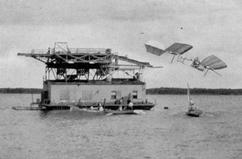
The Langley Aerodrome plunges into the Potomac River immediately
after its launch on 7 October 1903. The photos made it apparent that
the front wings had twisted, forcing the aircraft down. Engineers said
it was too lightly built; the wings hadn't the strength to remain
properly aligned. Witnesses said the front guy post had caught on
the catapult. Both could be correct. Each guy post was attached to
the airframe ahead of its respective main spars. The wires from the
post to the main spars angled back slightly. If the bottom end of the
post caught as it left the catapult, the top end would have been
dragged forward, pulling on the wires attached to the spars. The
wires would have wrenched the spars up and forwards, twisting the flimsy
front wings so the trailing edges angled up and the leading edges
down..
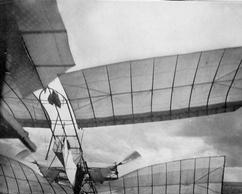
This photo was taken of the Aerodrome as it left the catapult. Note
the position of the trailing edges of the forward wings compared to
that of the one visible rear wing. The wings are twisted with the trailing edges
well up. The beam just visible in the left side of the photo is the
portion of the launch rail that Langley claimed to have caught the
Aerodrome as it left the track.
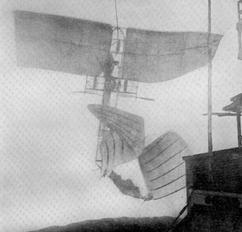
Between 7 October and 8 December 1903, Langley's crew altered the
catapult so it wouldn't catch the guy posts. They were only
partly successful. On the second launch attempt the front guy post
cleared, but witnesses aboard the houseboat reported that the rear
guy post caught and the tail was "dragged to pieces" before the
aircraft left the catapult. There was a pulley on the bottom end of
the rear guy post through which a control wire ran to the tail. If the bottom
section of the rear guy post caught and broke ― as Auriti's and
DeLaurier's wind tunnel research predicted it might ― the tension on
that control wire would have been released. If the part had stuck in
the track, the tail would have been pulled down and then pulled
apart as the aircraft continued forward. That same failure would
have also released the tension on the guy wires, allowing the rear
wings to fold up as the Aerodrome left the catapult and the wings
took its full weight.

As this photo shows, the bottom end of the rear guy post was
incredibly close to the launch track. It had only to drop a few
inches to catch. And it might have broken even without catching. The
quick acceleration by the spring-powered catapult created enormous
stress on the airframe members, none more than the guy posts.
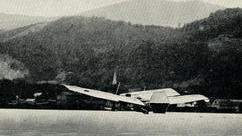
The Aerodrome just as it lifts from Lake Keuka near Hammondsport, NY
for a very short flight on 2 June 1914. Curtiss had discarded the
complex houseboat and catapult for simple pontoons as a way to
launch the aircraft. Pontoons also provided a way to safely recover
the aircraft and its pilot after the flight, something that was
sorely missing from the 1903 launch attempts.
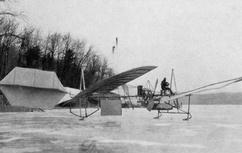
The Aerodrome ready for thrust tests on 9 March 1915. Lake Keuka is
frozen over; the pontoons have been removed and replaced with
skates.
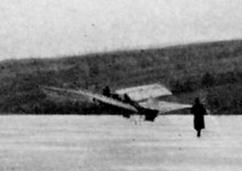
The Aerodrome about to take off on 10 March 1915; the rear skate has
not yet left the ice. Note that the right wings still display some "torsional
divergence" even though they have been substantially strengthened.
|